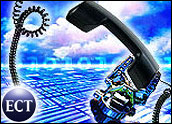
More than half of all consumers say a negative online experience leads to online and offline abandonment.
With the click of a mouse, a customer who has invested time and effort researching your products and services online, and who may have purchased something from your site or store in the past, will disappear forever because of a single, bad online experience.
Often the issue that caused the customer to abandon his or her transaction could have been resolved easily with help from a live agent. As such, leading retailers realize they can no longer think of their individual channels as self-sustained entities, but as integral parts of an entire brand operation.
Personalized Shopping Experience
Offering a truly personalized online shopping experience means not only delivering the right marketing message and merchandise, but also giving customers a choice in how they transact with your business by offering the right form of contact at the right time.
Sophisticated retailers are already using every piece of information they can gather to present individual customers with personalized marketing and merchandise selections based on their segments and personas. By using real-time data from each customer, companies can guide a customer to the exact products and services that meet his or her needs.
Why not leverage this same information to rescue online customers, should they reach an impasse and require live assistance?
Targeting and Engaging Customers
Interactive help options like “click to call” and “click to chat” deliver cross-channel personalization capabilities that allow companies to target and engage customers proactively based on their perceived needs. These technologies can have a profound effect on online sales, provided that the companies implementing them follow certain guidelines. These guidelines include:
- Proactively targeting “engaged” Web site visitors
- Offering the most appropriate contact based on context
- Moving shoppers seamlessly across channels
- Sharing information from one channel to the next
Can you imagine retail stores where nine out of 10 customers left without buying and no one ever asked them what they were looking for? Well that’s the state of affairs in the online customer service world. Engaging customers proactively is the equivalent of a sales representative walking up to a customer in a retail store and kindly saying, “May I help you with something?”
Companies that deliver personalized cross-channel experiences for their customers using click to call and click to chat have increased sales conversions, reduced Web site abandonment and improved service efficiency dramatically. This kind of contextualized approach to online customer interaction has increased conversion rates by as much as 20 percent and decreased handling times by up to 20 percent, according to a recent JupiterResearch report.
The Right Contact at the Right Time
The reality is that most companies would prefer not to have every customer inquiry result in a phone call or chat, and they invest heavily in providing self-service tools to address basic customer service issues. While many online marketers view this as an effective way to reduce costs, it sometimes exacerbates customer frustration by denying them the personalized service they need to complete a sale. The result is an unhappy customer and a missed opportunity for the company to generate revenue.
“In the future, retailers will need to develop a more balanced view of interactions across channels, optimizing for a combination of cost and satisfaction. Valuable customers, for instance, may require different service options than other customers,” according to a December 2006 study by Forrester Research.
In those instances where customer contact is desired or required, click to call and click to chat not only offer quality service and increase contact center efficiency, but also help metamorphose the contact center into a sales center by targeting individual customers based on their perceived needs and potential value. This can be done by evaluating individual customers according to profile or segment information.
For example, companies that segment their customer base into gold, silver and bronze categories can set a rule that presents click to call to gold (high-value) customers throughout their session, but only to silver and bronze customers once their shopping carts reach a certain threshold.
Gold customers get the piece of mind of always having the phone option should they have a questions, while lower-value customers are channeled to less costly service options like FAQs, e-mail or chat (unless they meet the shopping cart threshold).
Triggering Windows of Communication
These “scenario-driven” invitations are triggered only when shoppers match certain criteria, which allow businesses to determine when and how to communicate with customers. Business rules may range from:
- Number of items in a customer’s shopping cart
- Total shopping cart value
- Amount of time a customer has spent idle on a page
- Incomplete transactions
- Customer status/history
- Repeat use of self-service and search functions
- Hours of operation or call center availability
By understanding customers’ unique buying patterns and behaviors, you will know the most relevant mode of communication based on customer life cycle, preference and previous interactions. If you know your customers’ purchasing pasts, you are much more likely to be a part of their future.
Because there may be patterns in customer behavior, such as when customers abandon the Web site, or they exhibit hesitation suggesting the need for customer service, scenario-driven click to call and click to chat can keep customers engaged by offering a chance to speak with a live agent when they are most likely to need assistance.
Similarly, companies can deliver even greater personalization by leveraging scenarios to rescue consumers and pass online session data to customer service representatives (CSR) to create cross-sell and up-sell opportunities.
Saving Transactions
Let’s say a customer is shopping on your site and attempts to use a promotion code from an old magazine ad during the checkout process. The customer enters the code and hits “submit” to complete the purchase but an error message occurs.
For some reason, the promotion code is not being accepted. The customer tries again, but receives the same error message. At that moment, an invitation to speak with a customer service representative appears on the customer’s screen. The customer initiates a call.
Instantly, the customer is connected to the contact center and the session data from the customer’s transaction appears on the CSR’s screen. The CSR identifies the problem, an expired promotion code, and offers the customer a new code to use.
In addition, the CSR suggests a possible cross-sell based on the customer’s shopping cart contents, and pushes the product page to the consumer’s screen so that he or she can consider adding it to the cart.
In this case, the company was able to save the existing transaction by identifying the customer’s problem and offering help to resolve it, and offer the customer a targeted, contextualized experience.
Rethinking Strategies
Using a similar approach, a leading online retailer was not only able to increase conversion rates, but improve contact center efficiency dramatically by reducing its average call handle times by more than 70 seconds per call.
The increasing role that online shopping plays in developing overall brand loyalty has prompted many companies to rethink their channel strategies, customer acquisition and retention initiatives. Retailers that fail to provide a unified voice between the online and contact center worlds risk jeopardizing customer loyalty and sales.
Proactive service solutions like click to call and click to chat help to bridge this gap between online and offline sales channels by creating a continuity of experience for shoppers as they transition from the Web to an online chat or voice session.
With minimal effort, retailers can have the ability to leverage existing personalization and merchandising features to create rules that govern when and how they engage high-value prospects with live assistance.
The result is a satisfied customer that does not have to “start all over again” when he or she moves across channels, and a CSR that is much better equipped to deliver personalized service, convert sales and offer potential cross-sells, up-sells and promotions to the consumer.
John Federman is chief executive officer ofeStara, which develops contact solutions such as “click to call” and “click to chat” to bridge gaps between offline and online transactions.













































